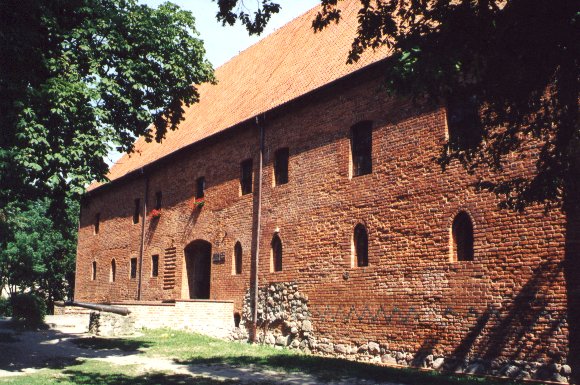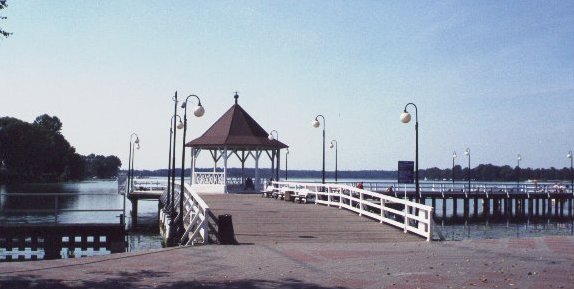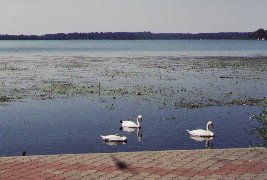Ostróda

Crusader Castle in Ostróda
Distance
Population
35.000 (2003)
Location and history
Ostróda is a short distance from as many as 15 lakes, five of which are within the city's area, closest to the town center, however, is Lake Drwęca. The city is also the central port for 3 channels. Through the Ostróda River flows the Drwęca, which, moreover, forms a special nature reserve.
In Prussian times, the city name was Osterode.
Ostróda gained market town rights in 1329. In this place was formerly the Prussian settlement Sasinow, which was conquered by the Crusaders at the end of the 13th century. In the years 1349-1370, the Order of the Crusades built a Gothic castle in the city. The fate of the town was closely linked to the changing history of the Masurian territory. The city was hampered in its development by the wars between the Crusaders, Poles and Lithuanians, the Swedish wars of the 17th century. as well as through fires and epidemics. On February 27, 1807, Emperor Napoleon arrived at the castle of Ostróda, where he resided until August of that year. In 1845-1852 the Ostróda-Elblag canal was built. In 1872 the first train runs through the city. In 1875, Ostróda had 5,746 inhabitants and has become a significant trading center, not least because of the canal. In 1939, Ostróda had 18,000 inhabitants and was given the nickname in the German press “The Pearl of Masuria”. During the fighting of Ostróda in 1945, almost all the old buildings, including the castle, were destroyed.
Today, Ostróda is an ever-growing center of tourism in Masuria (Mazury).
Tourist attractions
Remains of the city's Gothic defense walls
from the 15th century. at the Dominik Savio Church.
The Holy Dominik Savio’s Church
Gothic style (14th century), rebuilt after the devastation of World War II.
Crusader fortress
originally built in Gothic style, but later remodeled several times.
The castle was built in brick in the middle of the 14th century. as a seat for the comet of order. The four-winged building with a square inner courtyard was surrounded by a moat. On the first floor of the south wing was the chapel, refectory and comforter’etc. housing. In the 19th century. the castle was used as a court and office building, part of the rooms, however, for housing purposes. . The buildings thus contain a smaller museum for the history of the castle. The local public library is housed on the first floor of one of the wings. Another wing contains a restaurant. In the courtyard there is an outdoor scene.

Ostróda. From the promenade along Lake Drwęca.
The Most Holy Virgin Mary's Immaculate Conception Church
neo-Gothic, from 1856-75, the tower erected at the beginning of the 20th century.
The Evangelical-Augsburg Church
from 1907 in neo-Gothic style.
Polska Górka cemetery
Some of the tombs date from the first half of the 19th century. Here are buried Pastor Gustaw Gizewiusz, who belonged to a core Polish family and was a tireless advocate of Polish Polynesia in Masuria. He was born in 1810 in Pisz and settled in Ostróda in 1835 as pastor of the Polish Evangelical Church. In 1848 he was elected as a representative of the Polish people as a member of the German Reichstag, but died shortly after, 7 May 1848. – The cemetery also noted the Jewish tombstones and the neoclassical gate of the 19th century.
The General Building Gymnasium building
in eclectic style from 1907.
Bomhuset
The former boomhouse at Elementary School No.1, in neoclassical style.
The water tower
in neo-Gothic style from the transition between the 19th and 20th centuries.
potter gate (Brama Garncarska)
Foundations and brick remains of this gate, one of the three medieval city gates. Based on findings from the construction of PKO BP’s bank building, a reconstruction of the gate has been carried out.
House in pseudobarok style
from beg. of the 20th century. (ul. Armii Krajowej 3).
Pseudoclassical style house
from the end of the 19th century. (ul. Gizewiusza 15)
In Ostróda, several plans have been implemented and new measures are continuing, which together will again justify the city to the name “The Pearl of Masuria”, which Ostróda called before the war. These include: the castle's renovation, building and modernization of the boulevard along Lake Drwęca and the work of giving the city's central space – Plac Tysiąclecia – the appearance it had before the war.

Surrounding Area
Ostróda-Elbląg Canal :
Among the many attractions in this beautiful area, one must first mention the branched system of sailing routes under the name Ostróda-Elbląg Canal. There is scheduled traffic with passenger boats on the canal from May until the frost sets in in the fall. In addition, tourists can charter themselves and get individual tours organized on the canal.
Hiking trails:
For tourists who love hiking, two hiking routes with a total length of 25 km are recommended.
Kayak Routes:
Kayaks can use 5 specially designated and beautifully located canal routes.
Bicyclerute : Bicycle tourists can use bicycle routes in the hilly countryside as well as in the forests.
Environmental park “Park Krajobrazowy Wzgórz Dylewskich” distinguished by its special terrain forms. It is part of the high-lying, post-glacial landscape chain called Lubawski Garb (Lubawa-Humpback). In the park lies the highest point in the whole Masurian lake landscape: Góra Dylewska (312 meters above sea level) with a sloping slope where ski lifts are arranged.
Grunwald
(32 km to the south). In the plain of Grunwald, a historic battle took place in 1410 between the Crusaders' army on the one hand and Polish and Lithuanian forces on the other. On site is a memorial park and a monument. Every year around July 15, the anniversary of Jagiełło’s victory over the Crusaders, the Grunwald days are celebrated. The party is organized by the army, scouts, knights of knights and the local Grunwald Society. In addition to the solemnity of the monument, the Battle of Grunwald is staged with the participation of about 1000 knights from all over Poland. The main organizers of the staging of the battle are the Brotherhood Sword and Armbrush from Warsaw and the Gniew Commander's Banner.
Łukta
(northeast of Ostróda). This municipality contains especially scenic areas and is therefore attractive for tourism and as a recreational area. 90% of the countryside in the municipality is subject to some form of protection.
The nature reserve “Sosny Taborskie”
is located near the village of Tabórz. Here they grow amazing “Cell-pines” with a height of about 40 meters and very beautiful, smooth stems. The age of the trees can be up to 250 years. In the days of the sailing ships, the trees were an excellent material for masts.
Accommodation
Booking.com
Ostróda (Town official page)
Links to other pages
Ostróda (Town official page)
Powiat Ostródzki (Official page for Ostróda District)
Special links: Crusader castles and bishopric castles in northern Poland
Translated into English by Google Translate. Spangshus.dk accept no liability for any errors or omissions in translation.
Map

Rating
Search
Most used tags
churches (205) Castles (86) Monasteries (79) Town walls (74) Lakes (71) Town halls (67) Rivers (65) Castles1 (62) Mansions (55) Museums (51) Regional museums (38) Town gates (36) Abbey churches (35) Castle ruins (30) Cathedrals (26) Forests (25) Health resorts (24) Mounds (23) Water sports (23) National parks (22)Click for all tags
Denne side er også tilgængelig på dansk. This page and contents is (c) Copyright 2018- www.spangshus.dk. Based on Inviator software by ISCA Software